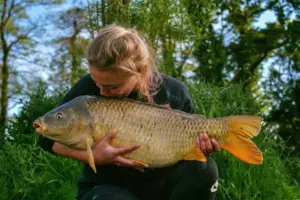The Nutritional Requirements of Carp
If you have had success using DT Baits upload your catch report and maybe we will share your story across our social media
Carp (Cyprinus carpio) are part of the Cyprinidae family of bony fish; they can survive in a temperature range of 3-35°C but have an optimum temperature for growth of 20-25°C. Wild carp prefer the middle to lower sections of the river in shallower levels of water with a silty substrate. Carp do, however, thrive in still water environments, such as lakes or ponds, where there is vegetative growth with a flora/fauna rich lake bed. This is all important for understanding their optimum nutritional requirements.
Carp are omnivores; they eat both plants and meat. Like all fish in the Cyprinidae family, they don’t have a true stomach but instead have a long intestine – longer than the length of their body. Since they don’t have a stomach (to store food in) carp need to constantly graze for food; this is why a small but constant supply of bait can work for catching them. Carp have a set of barbels around their mouth which act as feelers to help them search for food. Their barbels are packed with taste buds, as is the palatal organ – a fleshy pad in the roof of the mouth. The density of taste buds in these areas (around 300-400 per mm2!) gives an indication of how important this sense is in detecting food. In fact, because, carp have an inferior mouth position (pointing downwards) they can never actually see the food when they are eating it, but it does make things easier for grazing the bed of the lake/river.
The Carp’s Natural Diet
A carp’s natural diet is varied, this variation occurs during different stages of the life cycle and also the environment they are in. Young fish will depend on tiny plankton as their mouths are not yet big enough to feed on other sources of food; larger, growing fish, will feed on algae, aquatic vegetation and seeds, as well as larger plankton. However, the main source of natural food for larger carp are insects and small molluscs as well as detritus (the decomposing material that can be found on the bed of the lake). Carp will also occasionally feed on other small fish. In general, studies have shown around 40% of an adult carp’s natural diet will be found within the water column, whilst the rest is found at the bottom of the lake.
The Formulation of Artificial Feeds & Carp Baits
If carp are fed with an artificial feed, their nutritional requirements must be considered to ensure a healthy diet.
Typically, carp need to eat around 12g of protein for every kg of their body weight, which equates to 30-35% protein in the diet. They perform well with dietary fat levels of between 5-15%. Also required is 30-40% carbohydrate; this is considerably higher than in carnivorous species’ diets because carp have longer intestines and are able to digest the carbohydrate more readily. Vitamin requirements cannot be determined as easily as the main food groups because there are lots of depending factors, such as age and water temperature. Furthermore, some vitamins can be synthesized within the carp’s gut – such as vitamin C – which means they don’t have to be included in their diet. Minerals are typically included within the diet, but the fish will also uptake certain minerals directly from the water via the gills.
Formulating artificial feeds such as boilies or pellets involves putting together a mix containing the correct ratio of protein/oils and the other nutrients that provide the carp with everything they require at a given time of the year.
Seasonal Factors
Carp have different nutritional requirements of their feed dependant on the time of the year. This is because they are cold blooded meaning their body temperature changes in-line with their environment.
For example, during the winter when the water is cold, and the fish’s metabolic rate has slowed, they require a low protein diet because they are unable to digest the feed as efficiently due to the cooler water temperature. It is during these months that a carbohydrate-based feed is better suited as the carp can digest them more readily. Also, during the winter, carp require less feed as they feed less actively.
As the air temperature begins to warm in the spring, the water temperature warms at a slower pace and as the carp start to become more active, they will begin to search for food. At this time, the carp will benefit from a higher protein diet to allow them to regain the weight they have lost during the winter months. Some feeds use immune boosting ingredients (such as probiotics and beta-glucans) to aid the fish’s immunity while still sluggish following the winter. Once the water has warmed, these ingredients should not remain in the diet as they may lead to an exhaustion of the immune response.
As the summer months heat the water, the carp will start to feed at a more constant rate as their metabolism becomes more stable. At this time, food should be readily available owing to the build-up of natural food sources, this provides the carp to with a more constant supply of food which also aids in digestion. During this period, the required protein level returns to around 30% as the carp would have likely regained the weight lost during the previous to the winter.
In the autumn the carp begin to feed more heavily to put on the weight to sustain them for during the winter months. Around this time, the carp benefit from a higher fat diet to allow them to store the excess fat in their muscle for use later in the winter.
Environmental Factors
As we’ve seen, carp prefer warmer water: a carp’s metabolic rate is twice as fast at 30°C than 20°C, whereas temperatures below 7°C cause the rate to significantly slow down – so much so that there is no requirement for supplementary feeding if there is enough natural food in their habitat. Carp will also rely on reserves – such as fats or glycogen (a stored sugar) – accumulated in their tissues during the warmer months. After a winter of using its stores, a carp will have lowered resources and will start to feed heavily as the water temperature warms, this is to replenish its losses and begin to build up its reserves for the following winter.
In autumn, as the water cools, a supplement feed is consumed at a ratio of 1.3-1.5% body weight per day. In these months a high protein feed is not necessary as the protein requirement of the fish is very reduced – the fish aren’t growing. Studies have shown that there is no difference in growth rates or survival between fish fed a 41% protein pellet diet or a 10% protein cereal diet. In fact, excess protein level in the diet will result in the release of higher levels of ammonia (a deadly toxin) into the water from the fish.
Where supplementary winter diets are provided for the fish, they are done so to maintain fish weights (rather than growth) meaning the stores of energy in the tissue can be used for growth in the spring.
Where proteins are reduced in a diet, they are replaced with carbohydrates which are easily digested by the fish. So, a cereal with 10% protein and 60-70% carbohydrate is not only relatively cheap, but also nutritionally valuable to the carp. However, this is not a long-term diet.
As the temperature of the water increases so does the energy requirement of the carp present in the water. Often as the water temperature increases, there can be a period of time with low natural food sources present (such as early Spring) – here it is important to provide supplementary feed. A feed of 1.7-2% of their body weight/day is ideal. This will increase to 2-3% as the temperature warms and may even exceed this percentage in some circumstances dictated by the carp’s biology.
Biological Factors
When female carp are forming their eggs, they require extra feed to put more energy into the developing ovaries. It is often thought this process happens just before spawning (Spring), but the carp will have started developing spawning reserves as early as the Autumn before. At these times, carp benefit from protein rich diets; around 35-40% protein. On the other hand, excess carbohydrates and fats are not required within a pre-spawn diet as they can lead to a build-up of excess fat within the carp.
In summary, carp have different nutritional requirements dependant on three main factors: their environment (mostly temperature), biology, and life cycle stage. To get the best performance from the fish and to maintain the quality of its environment it is critical to match their diet to these requirements. The research and development of diets takes time and money, and quality ingredients are expensive. So quality diets can be costlier, but it is worth the investment if we care about the fish and the sustainability of the hobby.
Kennedy Dellicott, Y2 BSc at Sparsholt College
 REFERNCES
Benthic Zone. (2018). benthic zone lakes – Google Search. Retrieved from https://www.google.co.uk/search?biw=1906&bih=953&tbm=isch&sa=1&ei=nirgW_7pE6qQgAbb5bWoCA&q=benthic+zone+lakes&oq=benthic+zone+lakes&gs_l=img.3…11017.13104.0.13520.9.8.0.0.0.0.396.785.1j2j0j1.4.0….0…1c.1.64.img..5.0.0….0.alZUYYg5EI0#imgrc=-P1ldoVclReMwM:
Billard, R. (1999). Carp Biology and Culture. London: Springer.
Carp – Google Search. (2018). Retrieved from https://www.google.co.uk/search?q=carp&source=lnms&tbm=isch&sa=X&ved=0ahUKEwic45fJprjeAhUUbcAKHZyeAPAQ_AUIDigB&biw=1906&bih=953#imgrc=uQBD56RSzL2TCM:
FAO. (2018). FAO: Common carp home. Retrieved from http://www.fao.org/fishery/affris/perfiles-de-las-especies/common-carp/common-carp-home/es/
FAO. (2018). FAO: Natural food and feeding habits. Retrieved from http://www.fao.org/fishery/affris/species-profiles/common-carp/natural-food-and-feeding-habits/en/
FAO. (2018). FAO: Nutritional requirements. Retrieved from http://www.fao.org/fishery/affris/species-profiles/common-carp/nutritional-requirements/en/
Sanders, J., & Peterson, S. (2011). Carp. New York: Nova Science Publishers.
REFERNCES
Benthic Zone. (2018). benthic zone lakes – Google Search. Retrieved from https://www.google.co.uk/search?biw=1906&bih=953&tbm=isch&sa=1&ei=nirgW_7pE6qQgAbb5bWoCA&q=benthic+zone+lakes&oq=benthic+zone+lakes&gs_l=img.3…11017.13104.0.13520.9.8.0.0.0.0.396.785.1j2j0j1.4.0….0…1c.1.64.img..5.0.0….0.alZUYYg5EI0#imgrc=-P1ldoVclReMwM:
Billard, R. (1999). Carp Biology and Culture. London: Springer.
Carp – Google Search. (2018). Retrieved from https://www.google.co.uk/search?q=carp&source=lnms&tbm=isch&sa=X&ved=0ahUKEwic45fJprjeAhUUbcAKHZyeAPAQ_AUIDigB&biw=1906&bih=953#imgrc=uQBD56RSzL2TCM:
FAO. (2018). FAO: Common carp home. Retrieved from http://www.fao.org/fishery/affris/perfiles-de-las-especies/common-carp/common-carp-home/es/
FAO. (2018). FAO: Natural food and feeding habits. Retrieved from http://www.fao.org/fishery/affris/species-profiles/common-carp/natural-food-and-feeding-habits/en/
FAO. (2018). FAO: Nutritional requirements. Retrieved from http://www.fao.org/fishery/affris/species-profiles/common-carp/nutritional-requirements/en/
Sanders, J., & Peterson, S. (2011). Carp. New York: Nova Science Publishers.
 REFERNCES
Benthic Zone. (2018). benthic zone lakes – Google Search. Retrieved from https://www.google.co.uk/search?biw=1906&bih=953&tbm=isch&sa=1&ei=nirgW_7pE6qQgAbb5bWoCA&q=benthic+zone+lakes&oq=benthic+zone+lakes&gs_l=img.3…11017.13104.0.13520.9.8.0.0.0.0.396.785.1j2j0j1.4.0….0…1c.1.64.img..5.0.0….0.alZUYYg5EI0#imgrc=-P1ldoVclReMwM:
Billard, R. (1999). Carp Biology and Culture. London: Springer.
Carp – Google Search. (2018). Retrieved from https://www.google.co.uk/search?q=carp&source=lnms&tbm=isch&sa=X&ved=0ahUKEwic45fJprjeAhUUbcAKHZyeAPAQ_AUIDigB&biw=1906&bih=953#imgrc=uQBD56RSzL2TCM:
FAO. (2018). FAO: Common carp home. Retrieved from http://www.fao.org/fishery/affris/perfiles-de-las-especies/common-carp/common-carp-home/es/
FAO. (2018). FAO: Natural food and feeding habits. Retrieved from http://www.fao.org/fishery/affris/species-profiles/common-carp/natural-food-and-feeding-habits/en/
FAO. (2018). FAO: Nutritional requirements. Retrieved from http://www.fao.org/fishery/affris/species-profiles/common-carp/nutritional-requirements/en/
Sanders, J., & Peterson, S. (2011). Carp. New York: Nova Science Publishers.
REFERNCES
Benthic Zone. (2018). benthic zone lakes – Google Search. Retrieved from https://www.google.co.uk/search?biw=1906&bih=953&tbm=isch&sa=1&ei=nirgW_7pE6qQgAbb5bWoCA&q=benthic+zone+lakes&oq=benthic+zone+lakes&gs_l=img.3…11017.13104.0.13520.9.8.0.0.0.0.396.785.1j2j0j1.4.0….0…1c.1.64.img..5.0.0….0.alZUYYg5EI0#imgrc=-P1ldoVclReMwM:
Billard, R. (1999). Carp Biology and Culture. London: Springer.
Carp – Google Search. (2018). Retrieved from https://www.google.co.uk/search?q=carp&source=lnms&tbm=isch&sa=X&ved=0ahUKEwic45fJprjeAhUUbcAKHZyeAPAQ_AUIDigB&biw=1906&bih=953#imgrc=uQBD56RSzL2TCM:
FAO. (2018). FAO: Common carp home. Retrieved from http://www.fao.org/fishery/affris/perfiles-de-las-especies/common-carp/common-carp-home/es/
FAO. (2018). FAO: Natural food and feeding habits. Retrieved from http://www.fao.org/fishery/affris/species-profiles/common-carp/natural-food-and-feeding-habits/en/
FAO. (2018). FAO: Nutritional requirements. Retrieved from http://www.fao.org/fishery/affris/species-profiles/common-carp/nutritional-requirements/en/
Sanders, J., & Peterson, S. (2011). Carp. New York: Nova Science Publishers. 